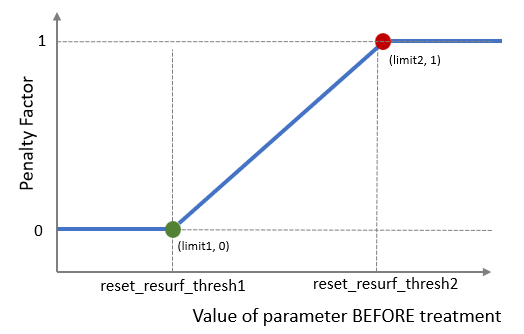Resets - Distresses
Overview
In the Cassandra derault Road Network model, distresses normally documented with visual inspections or Image Recognition are modelled using an S-Curve, as discussed on this page and this page. We recommend you briefly review these pages to ensure that you understand the three key parameters that control the shape of the S-curve, and hence also the rate of distress progression.
In the default model we assume that all treatments will - under normal construction practices - initially reset all distress to zero. However, the rate at which the distress will appear again depends on (a) the treatment type; (b) the distress type; and (c) how much distress was present before treatment.
What this means is that after each treatment, the distress is reset to zero, but then the S-curve parameters - that control how fast the distress will re-appear and progress - need to be re-evaluated based on the above noted three factors.
Rehabilitation
When a rehabilitation is applied, all distresses are assumed to reset to zero. The S-curve parameters are also reset using the updated values for Expected Surfacing Life and Distress Probability after rehab. The procedure for calculating the updated expected values for AADI, IV and T100 as discussed on this page.
In the case of Rehabilitation - and unlike for Preservation and Holding treatments, no account is taken of the quantity of distress before treatment. This is because we assume a Rehabilitation will fully remove the mechanism that caused the distress and therefore reset the road to a pristine condition with no retained distresses waiting to re-appear.
Resurfacing
When a Resurfacing is applied, we assumed that the distress is initially reset to zero. However, the rate at which the distress may re-appear and progress is dependent on the quantity of distress before treatment.
The procedure for resettting distresses when a Resurfacing is applied is as follows:
First, reset the distress initially to zero (model keeps record of how much distress there was before).
Calculate the S-Curve resets (Initial Value, AADI and T100) as if the treatment was a rehabilitation.
Adjust AADI and T100 based on the quantity of distress before treatment.
The adjustment of AADI and T100 based on the quantity of treatment involves a Penalty Factor, which is a piecewise linear model (PLM) with the following shape:
 {width = “95%”}
{width = “95%”}
As shown above, the Penalty Factor involves two limits, both of which can be controlled using the lookup set related to distresses. These two limits work as follows:
Limit 1 - this is the threshold below which no penalty is applied to the Reset of the distress’s S-curve. This means that below this value, the reset is the same as for a Rehabilitation (for this distress only).
Limit 2 - this is the threshold above which a 100% penalty is applied to the Reset of the distress’s S-curve. This means that above this value, the AADI and T100 will be reduced to their minimum allowed values.
For example, if we assume that Threshold 1 is set to 5% and Threshold 2 is set to 20% for Alligator cracking and Resurfacing. Now, if a surfacing is applied on an element with 10% alligator cracking, the alligator cracking, the penalty applied to the AADI and T100 values will be (10-5)/(20-5) = 0.333;
Thus, if the expected AADI for the element is 10 years, it will now be reduced to 10*(1-0.333) = 6.67 years. A similar adjustment will be made for T100.
If, however, the alligator cracking before treatment was greater than 20% (threshold 2), then the penalty applied will be 1. This means that AADI and T100 will be reduced to their minimum allowed values. This will most likely mean that in such a case the model will make the distress re-appear (and then rapidly increase) after 1 or 2 years (depending on the minimum value allowed for AADI).
Holding Actions
The mechanism for resetting distresses for holding actions is identical to that explained above for Resurfacings. However, different thresholds are specified for Holding actions for the Threshold 1 and Threshold 2 shown in the figure above. Typically, we allow the distress to be somewhat higher in the case of Holding actions before a full penalty is applied.
See this page for details on the default values assigned for Threshold 1 and Threshold 2 for holding actions.